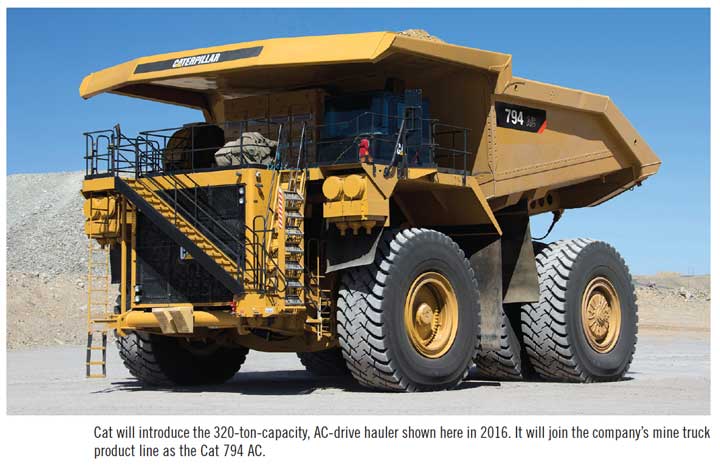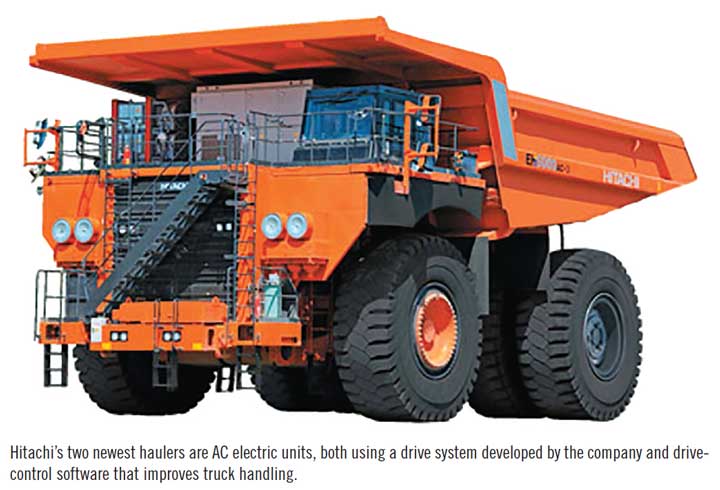Understanding that many mine operators are opting to squeeze more hours from their haul trucks before making replacement purchases, original equipment manufacturers (OEMs) are looking at different ways to help them improve performance and lower their cost per ton.
 “We know that our mining customers are under tremendous cost pressure,” Sudhanshu Singh, Caterpillar’s product line manager for large mining trucks, recently told E&MJ’s sister magazine Coal Age. “We have been focusing our continuous improvement efforts on existing assets to improve the cost per ton. One major push is to leverage the company’s technology research and development (R&D) to deliver higher value with autonomous mining, data analytics and retrofit kits.”
“We know that our mining customers are under tremendous cost pressure,” Sudhanshu Singh, Caterpillar’s product line manager for large mining trucks, recently told E&MJ’s sister magazine Coal Age. “We have been focusing our continuous improvement efforts on existing assets to improve the cost per ton. One major push is to leverage the company’s technology research and development (R&D) to deliver higher value with autonomous mining, data analytics and retrofit kits.”
Cat continues to invest in technology. In March, the company entered into a technology and predictive analytics agreement with Uptake, a Chicago, Illinois, USA-based company that has developed a dynamic analytics and insight platform used in several industries. Cat also purchased a minority interest in the company.
The relationship with Uptake will combine Cat’s product engineering and design expertise with Uptake’s software, application and data analytics expertise. As a result, Cat believes it will be able to transform the huge amount of incoming data it sees into useful information that it can feed back to the mines for on-the-spot decisions and planning purposes to further reduce owning and operating costs. (See “Earthmover OEMs Embrace ‘Big Data’ Analysis Agreements,” pp. 63-64, E&MJ, May 2014.
For mine operators looking to improve existing fleets, Cat now has retrofit kits for some technologies and improvements found on its newer trucks, such as extended brake-life materials, LED light kits and certain safety features, including one for working at height. “The working-at-height retrofit kits allow the miners to install tie-off points on the truck,” Singh said. “These tie-off points have become especially popular with mechanics working on the 400-ton Cat 797s in Canada.”
An improved fuel map feature for haul trucks lets miners use the engine and power train software to determine optimum fuel consumption in a given haul cycle. “We have been able to work with miners to improve fuel consumption by 6% to 12%,” Singh said.
CAT’S NEW ELECTRIC ENTRY
Not all of its attention has been focused on existing-fleet improvements, however. After its acquisition of Bucyrus in 2011, Cat saw an opportunity to provide an option for customers who were interested in 320-ton-capacity trucks.
“We still believe that, in many applications, the 250-ton-capacity Cat 793 truck still delivers the best cost per ton, but some customers have asked for a 320-ton option,” Singh said.
In 2012, Cat launched the 320-ton Unit Rig MT5300. “We have been testing it since early 2013,” Singh said. “We have demonstrated very competitive cost per ton in studies at two different mine sites.”
Cat will commercially launch the MT5300 in 2016 as the 794 AC. The new Cat nomenclature identifies the truck as sized between the 793 and the 795. “We are launching it in a controlled way at targeted sites as a 320-ton Cat 794 AC mining truck,” Singh said.
The new truck is Caterpillar designed and fully integrated in the company’s manufacturing and product support system. It is manufactured in Decatur, Illinois, USA, where all Cat large mining trucks are built. “It has passed through the same quality and testing procedures as the other Cat trucks in Decatur,” Singh said.
In many ways, the 794AC’s design is similar to that of the 345-ton Cat 795F. “This gives the customer more confidence in the power train and engine performance,” Singh said. “The 795 electric-drive power train now has more than 2.5 million hours…Some 795s have achieved more than 8,000 hours operating time in a single calendar year. The 794 leverages all of the positive benefits the 795 has brought into the Cat network.”
HITACHI ADDS TWO MIDRANGE AC-DRIVE HAULERS
Cat isn’t alone in providing additional electric-drive options for its customers. Hitachi recently introduced two new models—the 200-ton EH3500AC-3 and the 240-ton EH4000AC-3—both equipped with an advanced AC-drive system developed by Hitachi. The company said it coupled the AC-drive system, which has a load-responsive IGBT inverter, with drive control software to better control travel motor speed and torque. The Hitachi drive-control system aims to achieve higher drive control performance by reducing tire slippage on acceleration and tire lockup during braking, and preventing chassis oscillation in a front-rear direction and tire skid while steering.
“This is a fully integrated truck from the drive to the frame,” Mace said. “We do not need to rely on another company’s technology. The slippage control on these AC-3 units prevent over-steering or drifting. The drive controls the pitch, eliminating that rebounding effect from an oscillating chassis. The anti-skid feature prevents over-steering on turns.”
Hitachi has not overlooked safety. At MINExpo 2012, the company introduced the SkyAngle feature giving the operator 360° vision around the truck. “We are currently working on an object detection feature that will be integrated into that system,” Mace said. Hitachi is also working on a collision avoidance system, which will be incorporated into its autonomous haulage system (AHS).

Mace mentioned that Hitachi engineers are working with Wenco to improve scheduling systems. “Many of these systems were geared toward larger operations and we’re hoping to scale that down for smaller operators,” Mace said.
Mace also said that Hitachi is looking to incorporate some of the popular technology from its smaller trucks into the larger trucks. As an example, he referred to maintenance access points where Hitachi has moved from vertical ladders to stairways with open access. “The cabs are being redesigned with LCD monitors replacing the traditional gauges and dials,” Mace said. Looking toward the future, Mace said Hitachi will connect both mechanical and electric drive trucks to Hitachi’s global eService.






